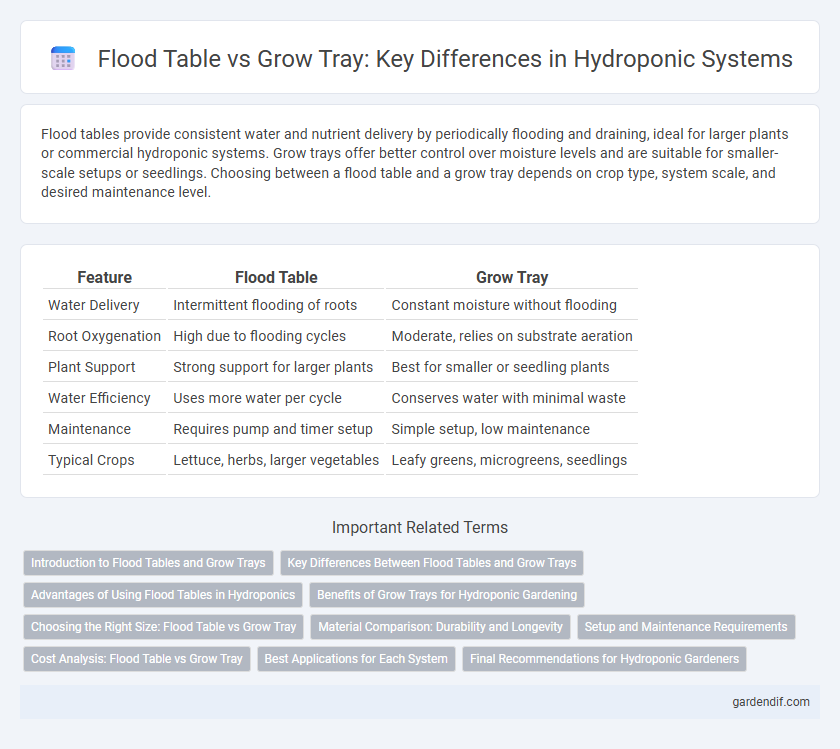
Flood table vs Grow tray Illustration
Flood tables provide consistent water and nutrient delivery by periodically flooding and draining, ideal for larger plants or commercial hydroponic systems. Grow trays offer better control over moisture levels and are suitable for smaller-scale setups or seedlings. Choosing between a flood table and a grow tray depends on crop type, system scale, and desired maintenance level.
Table of Comparison
| Feature | Flood Table | Grow Tray |
|---|---|---|
| Water Delivery | Intermittent flooding of roots | Constant moisture without flooding |
| Root Oxygenation | High due to flooding cycles | Moderate, relies on substrate aeration |
| Plant Support | Strong support for larger plants | Best for smaller or seedling plants |
| Water Efficiency | Uses more water per cycle | Conserves water with minimal waste |
| Maintenance | Requires pump and timer setup | Simple setup, low maintenance |
| Typical Crops | Lettuce, herbs, larger vegetables | Leafy greens, microgreens, seedlings |
Introduction to Flood Tables and Grow Trays
Flood tables and grow trays are essential components in hydroponic systems, designed to optimize plant growth by controlling water and nutrient delivery. Flood tables provide a large, shallow area where plants can be periodically flooded with nutrient-rich water, enhancing oxygenation and root development. Grow trays, typically smaller and more portable, offer a versatile platform for various plant types, enabling efficient water drainage and easy maintenance in hydroponic setups.
Key Differences Between Flood Tables and Grow Trays
Flood tables provide a large, flat surface that floods evenly with nutrient solution, allowing roots to access water and oxygen efficiently, ideal for large-scale hydroponic systems. Grow trays are smaller containers that hold substrates or growing media, designed for individual plant groups, offering more control over watering and nutrient delivery. The key differences involve scale, water distribution method, and suitability for plant types, with flood tables emphasizing uniform flooding and grow trays focusing on versatility and precise nutrient management.
Advantages of Using Flood Tables in Hydroponics
Flood tables offer superior water and nutrient distribution compared to traditional grow trays, promoting uniform plant growth and higher yields. Their automated flooding and draining cycles enhance oxygen availability to roots, reducing the risk of root rot and disease. These systems also streamline maintenance and increase scalability for commercial hydroponic operations.
Benefits of Grow Trays for Hydroponic Gardening
Grow trays offer precise water and nutrient control, enhancing plant growth efficiency in hydroponic gardening. Their modular design facilitates easy handling and maximizes space utilization, making them ideal for scalable indoor farming. Unlike flood tables, grow trays reduce water wastage and root disease risks by allowing better drainage and aeration management.
Choosing the Right Size: Flood Table vs Grow Tray
Selecting the right size for hydroponic systems depends on space availability and crop type; flood tables offer larger surface areas ideal for commercial setups, while grow trays suit smaller, home-based operations. Flood tables enable better water circulation and root expansion, supporting high-density planting, whereas grow trays provide flexibility for varied plant sizes and easy maintenance. Proper sizing ensures optimal nutrient delivery and growth efficiency, maximizing yield and resource use in both flood table and grow tray systems.
Material Comparison: Durability and Longevity
Flood tables are typically made from robust materials such as high-density polyethylene (HDPE) or stainless steel, offering superior durability and resistance to corrosion, making them ideal for long-term hydroponic systems. Grow trays, often constructed from lighter plastics like polypropylene or PVC, provide adequate durability but may degrade faster under constant water exposure and UV light. Choosing flood tables ensures a prolonged lifespan and minimal maintenance, while grow trays demand more frequent replacement due to their comparatively lower material resilience.
Setup and Maintenance Requirements
Flood tables require a more complex setup with a built-in drainage system and automated water cycling to ensure consistent flooding and draining cycles. Grow trays feature a simpler configuration, often placed on a flat surface with manual watering or basic irrigation systems, making them easier to maintain. Maintenance for flood tables involves regular checks of pumps and timers to prevent clogs, while grow trays need frequent monitoring of water levels and nutrient solutions to avoid stagnation.
Cost Analysis: Flood Table vs Grow Tray
Flood tables generally require a higher initial investment due to larger structural components and integrated drainage systems, while grow trays offer a more cost-effective entry point with simpler designs and materials. Operating costs for flood tables can be lower over time because of efficient water recirculation and reduced labor for maintenance compared to grow trays, which may need frequent manual irrigation and cleaning. Understanding the total cost of ownership, including setup, maintenance, and scalability, is essential for selecting the optimal hydroponic system for specific growing needs.
Best Applications for Each System
Flood tables excel in commercial hydroponic farms and large-scale leafy green production due to their efficient water recirculation and uniform nutrient distribution. Grow trays are ideal for hobbyists and small-scale growers, offering simplicity, affordability, and easy customization for a variety of plants such as herbs and microgreens. Each system optimizes space and resource use differently, with flood tables suited for high-volume, automated setups, while grow trays provide versatility for diverse plant types and growth stages.
Final Recommendations for Hydroponic Gardeners
Flood tables offer superior water distribution and oxygenation, making them ideal for large-scale hydroponic operations aiming for consistent plant growth. Grow trays provide flexibility and ease of maintenance, suitable for beginners or small-scale hobbyists seeking cost-effective options. Hydroponic gardeners should choose flood tables for enhanced productivity and uniform nutrient delivery, while grow trays work best for experimental setups and space-limited environments.
Flood table vs Grow tray Infographic

 gardendif.com
gardendif.com